Artist Combines Architecture And Ecology For Spellbinding Public Intervention

"I created 'Golden Waters' so when the public engages with the work, they are not only drawn in, but are able to stop, think and observe," artist Grimanesa Amoros explained to the Huffington Post. "By looking, we are informing ourselves and deciding how to get involved with what we see. During the moment of engagement, the work hopefully takes viewers into a space of reflection where they themselves might be surprised by their reactions."
Amoros is the mind behind "Golden Waters," an electric artistic intervention spread atop the 50-mile-long body of water that is the Arizona Canal. Using an LED tubing system, Amoros crafts a glowing serpentine stream at the nexus of light and water, nature and metropolis.
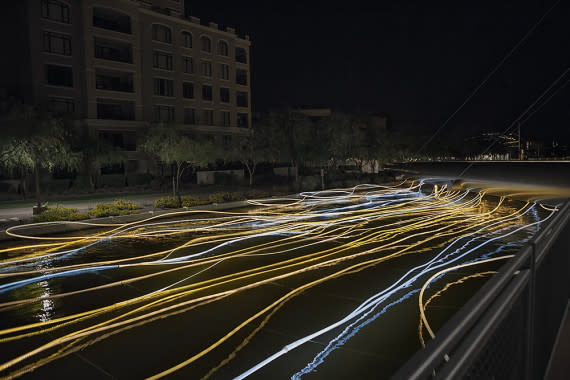
Love HuffPost? Become a founding member of HuffPost Plus today.
Born in Lima, Peru, Amoros was inspired by her childhood travels when crafting the public art piece as well as the Peruvian people's ability to combine beauty and survival. "As a teenager, growing up in Lima, I would travel throughout Peru whenever I could," she said. "My goal was to see as many of the country’s historical sites as possible." Specifically, Amoros was moved by the Uros Islands in Lake Titicaca in southeast Peru, floating islets made entirely out of totora reeds. "The pre-Incan Uros people, who lived on 42 self-fashioned floating islands, built everything out of these reeds -- from houses to watch towers."
"The Uros people are very similar to the Hohokam people. They both used ingenuity to survive and improve their existence." The Hohokam people, also known as the Canal Builders, were another major source of inspiration for Amoros. "They developed an ingenious irrigation system that enabled them to become the most skillful farmers in the Southwest as early as 300 A.D.," she said. Their use of the canal inspired the central concept behind "Golden Waters," Amoros' piece.
Amoros' work has long employed the wondrous beauty of light to explore concepts of identity, home and community. According to Pheonix New Times, the artist discovered her passion for the stuff accidentally during a sleepless night in Iceland. "Unable to sleep one night, she went outside and witnessed an incredible display of lights in the northern sky. Tempted to grab her camera, she decided instead to simply stay in the moment. But she longed to share the moment with others, and it’s informed her practice ever since."
"Golden Waters," sponsored by Scottsdale Public Art, will be on view in Scottsdale, Arizona until Sept. 30, 2015.
Hypnotic Bridges
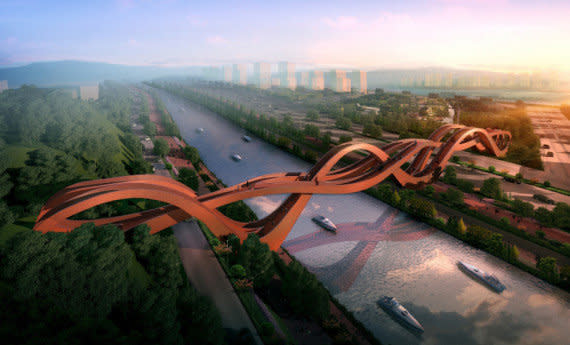
The rendering won an international competition associated with a new public park in the area last year, and the project is currently under construction. “The construction with the intersecting connections is based on the principal of the Möbius ring,” states Michel Schreinemachers on the NEXT website. “On the other hand it refers to a Chinese knot that comes from an ancient decorative Chinese folk art,” John van de Water adds.
Indoor Parks
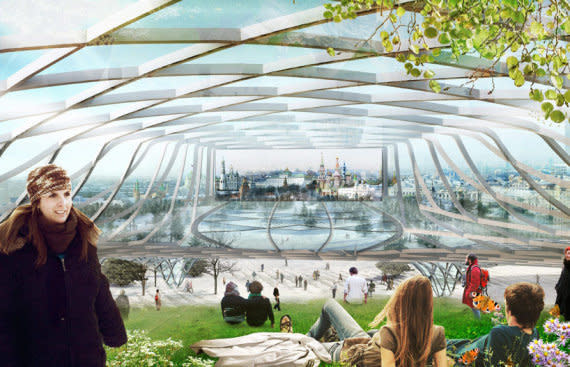
The park will feature four landscape typologies -- tundra, steppe, forest and wetland, integrating augmented micro-climates that will enable the park to function as a public space throughout Russia’s extreme winters. Essentially, the quasi-indoor environments will involve regulated temperatures, controlled wind and simulated daylight that encourage 24/7, year-round park pleasure. As Diller Scofidio +Renfro aptly put it, "Zaryadye Park will embody the past and the future simultaneously."
Invisible Architecture
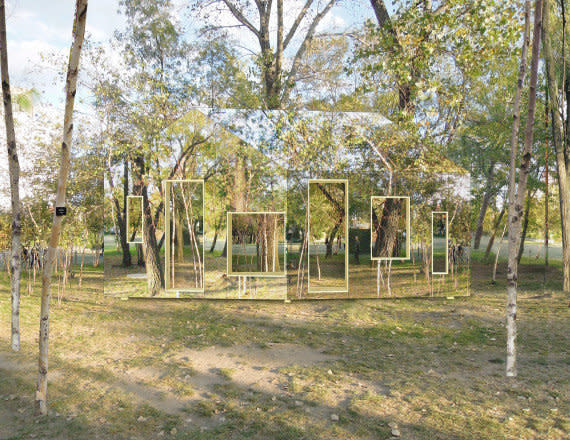
But there's also the shorter, less flashy structure (pictured above) designed by New York-based architecture firm stpmj. The parallelogram-shaped barn would be made of wood and sheeted with mirror film, at a cost of $5,000. The idea is to "blur the perceptual boundary" between object and setting, according to a statement sent by the architects to The Huffington Post earlier this year. We have to say we're impressed with architects' ability to push the boundaries of what invisible really means.
Natural Disaster-Proof Forts
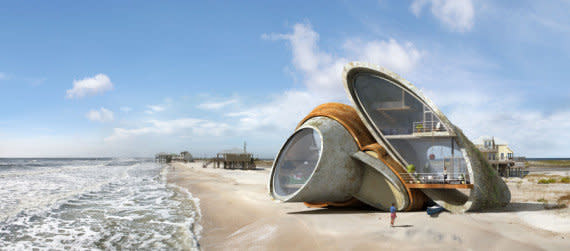
González created hypothetical blueprints for his forts, illustrating how his bulbous, concrete structures would better suit the fraught island's populous. You can learn more about the project on his website. Keep in mind, these structures are not yet slated for reality, but they certainly paint an interesting picture of what futuristic island homes could look like.
Sweaters for Skyscrapers
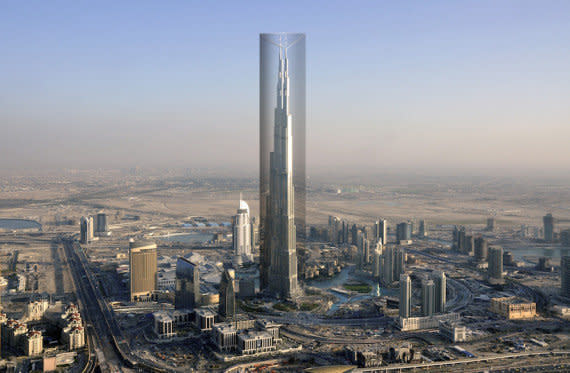
We learned about the project, dubbed EXO-BURJ, in 2014. The strange, sock-like covering would wrap around the entire building, from spire to ground level, in a "super-lightweight, reflective and semi-transparent fabric material," according to a description by the Dubai-based think tank, OP-EN. The temporary "sweater" would reflect the expansive urban scenes around it, turning the Burj Khalifa into a massive mirror in the vein of Christo and Jeanne-Claude.
Green Power Plants
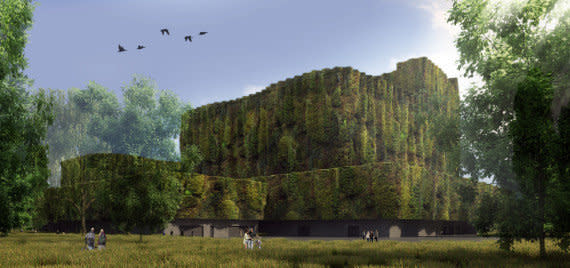
Here's how it would work: The architecture firm AZPA (Alejandro Zaera-Polo Arquitectura) plans to turn the existing Wedel Vattenfall power plant in Germany into a new industrial complex, one that would be built up from the previous facilities and wrapped with a corrugated skin of creeper plants. This strategically-placed skin would not only soften the exterior aesthetic of the plant, but it would create a sheath of creepers to absorb CO2 emissions. AZPA describes the endeavor, imagined in 2013, as "an attempt to resolve the conflict between the natural ecology and the manmade environment."
Floating Pools
![It's hard not to love this New York design project from Family and PlayLab, which plans to bring a giant filtration system to the murky waters between Manhattan and Brooklyn. The project would take the shape of a 164-foot long floating pool set to take shape in 2016 -- if all funding efforts go as planned. If there are swimming pools in our future, let them look like this.<br> In a statement released at the end of 2013, pool masterminds Archie Lee Coates IV, Dong-Ping Wong and Jeff Franklin announced they are beginning construction on Float Lab, an experimental version of the planned 164-foot +POOL. They raised the funds for the smaller pool (35 feet by 35 feet, to be exact) through their last Kickstarter endeavor. With a launch date planned for this summer, the mini pool will put the team's filtration membranes to the test in real-river conditions.<br> "We dont think about using the river recreationally at all," Coates explained in a previous interview with Huff Post. "So as an architect you think, 'What if we could change that or propose an idea that could change that?' We decided to pitch [+Pool] to the world. We just had no idea the response we would get."](https://s.yimg.com/ny/api/res/1.2/QSNgU14J6j1ffrPiZMlybg--/YXBwaWQ9aGlnaGxhbmRlcjt3PTk2MA--/https://img.huffingtonpost.com/asset/55b7c81a1400002e002e116b.jpg)
In a statement released at the end of 2013, pool masterminds Archie Lee Coates IV, Dong-Ping Wong and Jeff Franklin announced they are beginning construction on Float Lab, an experimental version of the planned 164-foot +POOL. They raised the funds for the smaller pool (35 feet by 35 feet, to be exact) through their last Kickstarter endeavor. With a launch date planned for this summer, the mini pool will put the team's filtration membranes to the test in real-river conditions.
"We dont think about using the river recreationally at all," Coates explained in a previous interview with Huff Post. "So as an architect you think, 'What if we could change that or propose an idea that could change that?' We decided to pitch [+Pool] to the world. We just had no idea the response we would get."
Inflatable Concert Halls
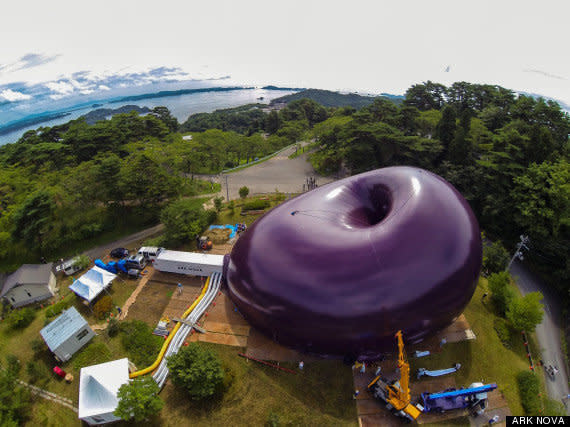
"I am honored to have been asked to design Ark Nova for the Tohoku area," Kapoor states on the Ark Nova site. "The structure defines a space for community and for music in which color and form enclose. I hope that the devastation can be overcome by creativity. Music can give solace and bring community together and in so doing can help us to see we are not alone."
Wooden Skyscrapers
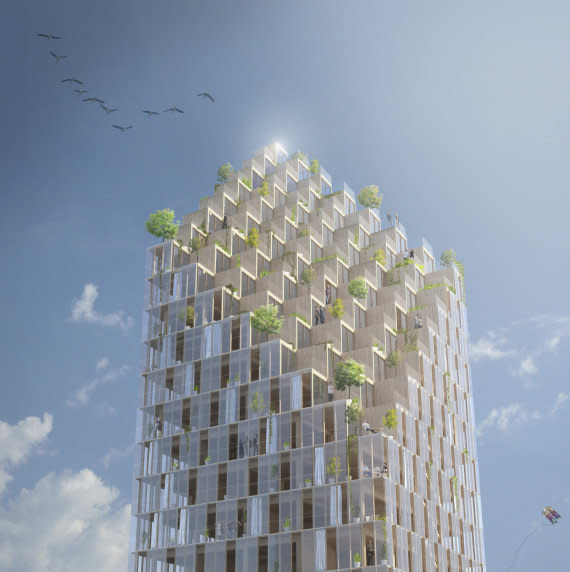
And it might become a reality if Scandinavian practice C.F. Møller and DinnellJohansson -- 2013's winners of the HSB Stockholm architectural competition -- follow through with their rendering for the world's tallest wooden skyscraper. The design (pictured above) is one of three ”ultra-modern residential high-rises” planned for Stockholm’s city center in 2023, but the catch is, only one of these proposals will actually be built.
Sponge Parks
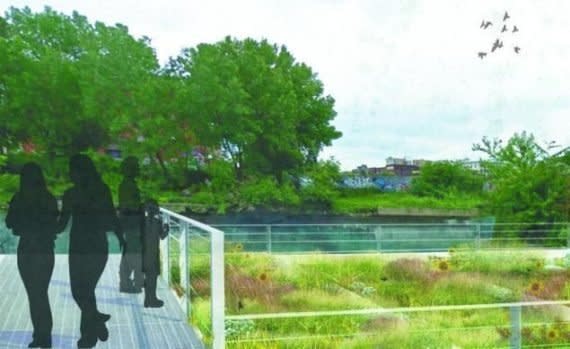
The Gowanus Canal Conservancy and the landscape architecture firm dlandstudio announced in the summer of 2013 that they plan to employ a system of landscape buffers and remediation wetlands to slow, absorb, and filter Gowanus' polluted sewer runoff before it reaches the canal. So, not only will the Sponge Park turn 11.4 acres of contaminated fields into a pleasant waterfront arena, it will provide a means of absorbing harmful pollutants that continue to ooze into the industrial battlefield.
"In a process called phytoremediation, specially selected plants metabolize pollutants and heavy metals present in the contaminated water," the American Society of Landscape Architects explains on its website. "Dirty water from the combined sewer system is captured in underground storage tanks and slowly released into the landscape."
Sci-Fi Skylines
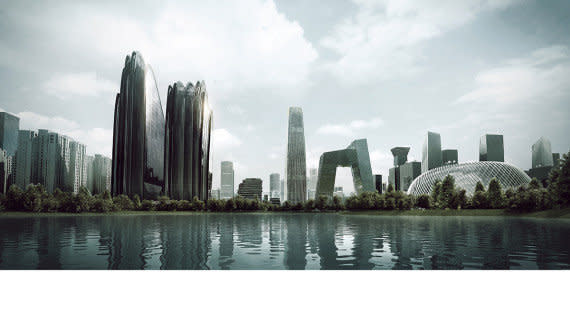
This article originally appeared on HuffPost.

